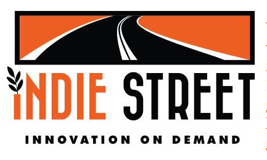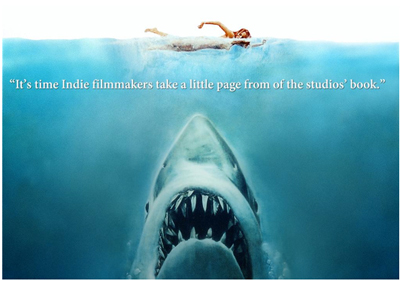By Jay Webb

Previously: Indie Street Post #4: Maximizing Your Story-telling Capital
Indieconomies of Scale, Part 3 (of 4): Distribution
Distribution and marketing are the business areas where we at IndieStreet are really getting excited about the great potential effects of Indieconomies of Scale. Empowering a group of Independent artists to unite and grow together as a trusted brand has not been a realistic option until recently. Indie filmmakers didn’t even have great ways to find each other before the rise of social networking. And now, just by cooperating with one another and utilizing some emerging technologies, a small group of artists can gain negotiating power, release momentum, and expand customer reach in ways comparable to a larger distribution company.

As human beings we are each looking for our own path and purpose, and through our journey we will surely run across successful people or companies out there that we don’t “like” or may not agree with. The mistake that many of us make is to take these entities as a whole, and not try to absorb or learn from different aspects that makes them successful. If there is any way we can learn from people we don’t like and apply their successful techniques into our own value system, than why the hell not? Just because I don’t like the way Miley Cyrus holds herself does not mean I cannot appreciate her publicity strategy and take note of the unwavering effectiveness of shock marketing on American citizens. If given enough thought, there might be a way that IndieStreet can apply this proven technique, but mold it to fit into our “not very Miley” brand identity at IndieStreet. This general life and business statement can also be applied to the Studios that many Indie filmmakers cringe over. Those “money grubbing suits wouldn’t know a piece of art if it was thrown into their energy drink by their own child when one of their underpaid nannies wasn’t looking.” While there is truth to the capitalistic, at times depressing, ways of the big studios, that does not mean we should just dismiss them. Why not learn what they do on Hollywood Boulevard and see if there are techniques that we can apply to the different values we have here on IndieStreet. What we learn, and can now apply, is how the studios have benefited from distribution economies of scale.
The OLD way: Studios had all the distribution power because in old models they were the only ones who film outlets would deal with. What we like to call a necessary evil. The theaters, the sell through chains, and rental stores couldn’t dedicate their resources to discovering individual films for sale. It just didn’t work in that model. It was simply inefficient business for a Blockbuster or a Loews to even think about talking directly to a filmmaker for distribution, so we had to hope and pray for a distribution deal through a studio or even worse go through a few middle men to get to a company with real distribution power.
The NEW WAY: Now that streaming and VOD are extremely high quality and more than viable for viewing long-form feature film content, the Indie filmmaker has access to new outlets every day that can make them real dollars without reliance on greedy third parties. The small problem is reaching all these potentially accessible customers, so it’s time Indie filmmakers take a little page out of the studio’s book. Let’s think about it…Large outlets of the past would only listen to the studios because they had a large number of films, a flowing pipeline of content, and a trusted reputation of quality (to varying extents).
In today’s Internet age, what is stopping a group of Independent’s from achieving all three of these? Our answer: a lack of organization and cooperation. The technology is there for a group of filmmakers to create their own streaming DIY distribution group. You can join a group like IndieStreet, create your own niche based on genre, Indie community location, etc…or you can just take advantage of a group’s increased deal-making power through traditional outlets. There are many possible ways to tackle the concept, and each filmmaker will have their own path of course. In the past, a single filmmaker (or a group of filmmakers) did not have this option of supplying their films directly to their customers without adding significant additional expense. And now, not only is the option there for self distribution, but with a little bit of pro-active research and group discovery, these direct distribution efforts can take on a pseudo studio feel with Indieconomies of scale.
There are certainly companies out there that are starting to make moves in this direction, and it gives us huge smiles. We have seen a few micro-budget producers putting out websites offering digital streaming and downloads of their films (along with a few films from their friends & professional network also available). A little step like this can give a small production company a slowly growing distribution brand identity that may eventually be enough revenue to fuel a continuous flowing cycle. Imagine that! Not having to raise $ every time you NEED to make another film. And what is more wonderful about taking these newfound steps is that they are not steps into a corner or leaps of faith like distribution deals in the past. Most of us (producers/distributors/etc.) with a cooperative mindset like IndieStreet are not suggesting that a filmmaker not also explore other outlets. You can carve out a non-exclusive direct distribution route within your group, but still leave rights open for other distribution media and outlets.
When it comes to distribution, Indie Street looks at the “group” direct distribution strategy as a no brainer. The power from numbers cannot be negatively impactful when non-exclusive, and the added potential that a group can give to distribution power and exposure for your film is unquestionable. Next post we will discuss the marketing Indieconomies of scale; which in my opinion, are the most accessible and easy to apply for all filmmakers. So stay tuned, but for now, get back to working on something you love.
Next Up: Indieconomies of Scale Part 4: Marketing
Jay Webb – Jay Webb is an independent film producer/writer and small business entrepreneur who has discovered through trial by fire that it is literally impossible for him to choose personal capitalism over passion. Always balancing a life on both sides of the tracks, he has discovered that helping good people succeed (success=happiness) is the core of what drives him. The IndieStreet direct & “group distribution” film initiative is his personal Autobahn.
Web: IndieStreet.com
Twitter: @indiest_films





